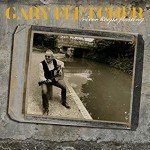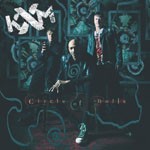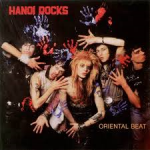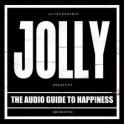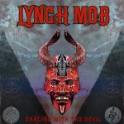JOLLY (Joe Reilly) Interview
None of the interviews I have conducted so far has ever been as revealing about the artist as this one! Apparently, I’ve been choosing the wrong breakfast cereal for the past (almost) four decades of existence – thanks for clarifying that, Joe! Then again, you don’t name your band “JOLLY” if you lack a sense of humour, right? With an album as impressive as “The Audio Guide To Happiness, Part II” only days away from being released I decided to prepare a few questions for the band – questions that were answered in an honest and pretty entertaining way by keyboardist Joe Reilly. Read on and find out what makes this US band so special!
By Yiannis (John) Stefanis.
- Hi Joe. We are very happy to be hosting you on our pages. Even though you have been around since 2006 there will be people who, like me, are just learning about you now. In view of that, can you please provide us with a short bio?
Joe: Hey GTRT, thanks for having me! It’s true that the first incarnation of JOLLY, which was me, Louis, and Anadale, had met to practice once in December 2006, but the band’s true formation and start point of development was in 2008. Louis and Anadale started talking through Craigslist, looking to start a band. Then Louis contacted me (we knew each other from high school and hadn’t spoken in about 6 years); though he knew me more as a guitar player, he remembered that I also played some piano/keyboard and asked me to join in that capacity. Then we drafted Mike Rudin, who Louis and I also knew from high school, to play bass. We parted with Mike very amicably in 2009, mainly due to commitment issues, and then Louis got Anthony, who he went to college with, to play bass. And we all lived happily ever after.
- “The Audio Guide To Happiness, Part II” is the band’s third studio effort but the second album under the auspices of Inside Out – a record label totally dedicated to Progressive music of all persuasions. How did you guys manage to strike a deal with such a prestigious company?
Joe: The short story is that our manager, who also manages Riverside, has a relationship with the label and introduced our music to them, and they liked it. InsideOut was bold enough to sign us, though we had no following whatsoever, purely based on faith in our music. We’re very grateful for that. The long story involves multiple suicide threats, a dangerous trek through catacombs in Austria, an agoraphobic clown named Eddie, and four diagnoses of feline leukemia. It would definitely be more appropriate to tell in an interview for the fourth album.
- The opening lines of “Guidance Three”, the opening track of “The Audio Guide To Happiness, Part II” suggest that one should first listen to “The Audio Guide To Happiness, Part I”. Is it important to first hear Part I to really appreciate the second part?
Joe: I’d say it’s more important than seeing Troll before Troll 2, but less important than seeing Kill Bill Vol. 1 before Kill Bill Vol. 2. Honestly, it depends if the listener is looking to “The Audio Guide To Happiness” solely as a body of music or as a musical and spiritual journey.
- The titles chosen for your last two albums suggest a certain lyrical/thematic connection or continuity between them. Is that also the case with regards the music on offer? Are these two albums different parts of the same musical journey or separate entities?
Joe: If you want to experience one part of the album as a set of songs, then I’d say each part holds up on its own, but they are definitely part of the same musical journey. And I think there’s something to be gained from hearing both parts. The melodic, lyrics, and thematic connections that you are referring to are there, and I think they work synergistically between the two parts. It’s like when there is a reprise in a musical; you have a character (or difference characters) singing a recurring melody in different contexts and tones. The recurrences are more powerful than just the one because they develop the character and storyline more.
- One of the first things that struck me about “The Audio Guide To Happiness, Part II” are the number of genres you have incorporated into your music – with some elements that might put off most Prog purists– yet, the way you have introduced these elements is not only impressive but also quite successful as far as I am concerned. Are you aware how others perceive this?
Joe: I’ve seen journalists comment on the incorporation of multiple styles within our music, sometimes as a positive thing and other times as a negative. Some people have complimented us on it, regarding the blends as relatively seamless, natural, and original. Others have said that it detracts from us having a musical identity, or that we’re a rip off of a million other bands. The four of us in JOLLY appreciate a lot of different styles of music, and these other genres make their way into our songs naturally. We’ve never forced a sound into our music for the sake of “pulling off” more genres. It’s never been “wouldn’t it be cool if we did a reggae part in this song?” It’s always been jamming, messing around, etc., and then suddenly we start playing a pop dance rhythm or something and it just makes sense for the song.
- On that same note, what is the strangest or most inappropriate (in your opinion) comment that you’ve ever heard about your music – the one that made you feel that the person writing the review hadn’t managed to understand your intensions at all? How do you take negative press, generally?
Joe: One journalist reviewed the album and said that the keyboard parts were awesome, but that the keyboardist had really stupid hair. I found that very off-putting because I shave my head, and hardly have any hair to call stupid. But seriously, we’ve gotten our share of negative reviews, and people who don’t like what we’re doing, whether it’s binaural tones or the music itself; but we’ve been fortunate enough to receive a lot of positive feedback as well. In general, negative press used to bother me more, but has less so over the years. I think I reached the point one day where I started to feel confident enough in what we were doing, probably because of the positive press and response from fans, to be able to just understand that it’s fine that there are people who don’t like us. Our music isn’t for everyone, and that’s okay; our goal isn’t for everyone to be a JOLLY fan. Just that we get to do what we and our fans want, and that we can earn enough money to afford electricity and the occasional sandwich from Subway.
- The press release that comes with the release talks about binaural tones – a scientific method that’s designed to help the listener achieve a level of happiness. Now, it could just be a placebo effect, but I admit to feeling quite happy having listened to your album. Can you explain the method behind this concept?
Joe: We have various binaural tone waves throughout both parts of the album, actually one type per phase (the album is broken into phases of the journey towards true happiness). They are at a very low volume, but can be heard during quieter parts of the album. The waves are created by the slight difference in two single frequency tones; on headphones, one frequency per earphone. Different wave types (delta, alpha, gamma) result from how music the difference is. Basically it causes our brains to perceive frequencies that our ears don’t; frequencies below the human hearing range. Sorry for that rather boring explanation. I used to be a high school science teacher. Research has shown that extensive exposure to these waves can enrich feelings of happiness, creativity, etc. Some people listen to binaural tones (sometimes with some mood music) while they are going to sleep. We thought it would be interesting to embed them in our music to try to feed the brain these feelings while you listen to JOLLY.
- Two of my favourite songs of the album are “Firewell” and “You Against The World” – songs that couldn’t be more technically and emotionally different. How is it possible for the same band to create such diverse offerings?
Joe: As I mentioned before, we like and listen to a lot of different stuff. Our common link as a band is mainly 90s rock/grunge. It’s also helpful that we have several different song writing approaches. Sometimes we’ll get something jamming as a full band, or Anadale will write something and bring it to us to work on, or I will come up with a progression and work on it with Anadale. And then we also add a lot of parts and write during the record process. There’s a lot of input from all of us on the songs, and we all have our own things that we like separate from the common core, so a lot of possibilities for creation become possible.
- I am sure that, by this stage, you will be completely bored reading about people’s perceptions of what the influences behind this album might be but I cannot help than mention names like Pain Of Salvation, Pink Floyd, Anathema and Dream Theater – all, of course, presented in a very personal and, dare I say, unique way. Are you annoyed with me?!
Joe: I’m a tad annoyed that you like classic Cheerios more than Honey Nut Cheerios, but other than that, I’m not annoyed at all. It’s always interesting to hear the comparisons and influences. I’m very appreciative of the progressive rock community, and I am a fan of Pink Floyd, but I never really listened to most of the prog bands that we’re compared to, like Pain of Salvation, Anathema, and Porcupine Tree. My influences are bands like Radiohead, Soundgarden, and Tears For Fears, singer/songwriters like Fiona Apple and Damien Rice, and then stuff like 80s pop music, film score music, and old school 40s jazz. This doesn’t mean that I am denouncing progressive rock or saying I dislike it, it’s just not what I grew up loving. I’m glad that the scene exists and that we’ve been able to attract fans of it.
- Last October, Hurricane Sandy inflicted some serious damage on the band’s property and studio jeopardising the creation of this album, however, your loyal fans stepped up and helped you finish “The Audio Guide To Happiness, Part II”. You must be really proud of them – can you comment on how this happened?
Joe: When Louis called me and told me that the entire basement had filled up to the top with ocean water, I was speechless. Everything was rolling along and going well until then, and though I knew a dangerous storm was approaching, I never anticipated something like this happening. Needless to say, it was a major bump in the road and we had to figure out how we could rebuild for the tour and make our album release a possibility. So we started a campaign on Indiegogo, looking to raise at least $10,000 to at least help subsidize our reconstruction (our expenses for rebuilding and the tour were actually more in the area of $30,000). I had no idea what to expect for our fundraiser, and I was floored when I saw us hit the $10,000 mark in 10 days. It was very heart warming to see the response and all of the encouraging comments coming in. JOLLY will be forever grateful to fans for enabling us to continue; they saved the day. It’s impossible to say how long it would have taken us to get back to touring shape and release the album had they not helped us out the way they did.
- How long did it take for “The Audio Guide To Happiness, Part II” to come to life and how much time did you end up spending in the studio recording it? How would you describe that process?
Joe: Audio Guide 2 was written and tracked before Part I was even released. Some of the songs on the album date back as far as 2008. This past year, we started reworking some of the recordings, tracked some new parts, remixed, and mastered it. So overall Audio Guide 2 was a 4-year experience. Of course we weren’t working on it the whole time, but it was still a long road. The process itself was an amazing experience; when you can trace a song’s development over four years, from birth to finished recording, you get a discrete timeline of everything that changed about it, and all of the memories associated with each retooling. It makes us feel like our lives really went into producing the finished product.
- Are you guys actively involved in the production duties or do you prefer to leave such things in the hands of professionals?
Joe: Our albums are recorded and produced in-house. Louis, our drummer, produced and mixed both parts of “The Audio Guide To Happiness.” We’re extremely lucky to have his production talents in our band (especially since we don’t have money to spend on professional recording). The only thing we do get a professional for is mastering. In fact, almost everything JOLLY creates is done in-house. Our videos and website are made by us as well (sometimes with some help from friends of family). It’s just something that smaller bands with no real budgets have to be able to do to get themselves out there without robbing a bank.
- The release date of the album is more or less a month from now. Apart from the obvious press campaign and interviews, have you decided on using any additional promotion platforms – a video, perhaps?
Joe: We’ll definitely be making videos to support the album. In the Youtube generation, it’s more important than ever to have video output to market yourself. Our channel is www.youtube.com/theincrediblejolly; be on the lookout!
- If your label was to grant you unlimited funds for the creation of a video to accompany a song from “The Audio Guide To Happiness, Part II” which song and what theme would you opt for?
Joe: That’s a good one. I would choose “The Grand Utopia.” The song lends itself to very dazzling and intricate imagery, stuff we’d only be able to pull off with a huge budget. If the funds were unlimited, I would probably also embezzle a fair amount to buy a million boxes of Fruit-by-the-Foot.
- Having friends in high places is something that every band needs, especially when that person happens to be the mighty skinsman Mike Portnoy. A year ago, you were in the privileged position of opening for his latest all-star project Flying Colours – what are your plans this time round?
Joe: Mike Portnoy asking us to play the Flying Colors show personally was the greatest honor we’ve received as a band. Flying Colors only played two shows in the US, and when I think of all of the NYC-area bands that they could have asked (especially ones with more fans), I’m blown away when I think that he chose us. Our upcoming plans are that we’re playing a European tour with Riverside this March, which will be awesome. Then Riverside will be coming to the US in May, and we’ll be doing 6 shows with them around the East Coast. I’m really grateful that we’ll be able to play for Riverside fans to promote Audio Guide 2; I hope it gets us out there enough to start really blossoming a career for JOLLY.
- Everything I heard on “The Audio Guide To Happiness, Part II” was enough to turn me into a fan – so now what I need to seal the bond, so to speak, is a live show. Do you guys plan on coming to London at all?
Joe: We’ll be opening for Riverside in London on March 14th and the O2 Academy Islington. Hope you can make it! We’ll invite you on stage to sing a song and throw M&Ms out to the crowd.
- Guys, it has been a pleasure preparing these questions for you. I want to wish you all success with regards “The Audio Guide To Happiness, Part II” and also to see you soon on UK soil. The last words are yours…
Joe: Thanks so much for giving me the opportunity to talk more to your readers about Audio Guide 2. We’ll be in the UK with Riverside for four shows this March: the tour dates are listed on our Facebook page (www.facebook.com/jollyband).
Also, I broke a window screen when I was 8 years old and blamed it on my 4-year-old brother. I just wanted to come clean about that and tell him I’m sorry I got him in trouble.
JOLLY loves you!
Featured Artist: JOSH TAERK
Since early 2020 Josh has been entertaining us with exclusive monthly live sessions,
Check out videos here: https://www.facebook.com/getreadytorockradio
David Randall presents a weekly show on Get Ready to ROCK! Radio, Sundays at 22:00 GMT, repeated on Mondays and Fridays), when he invites listeners to ‘Assume The Position’. The show signposts forthcoming gigs and tours and latest additions at getreadytorock.com. First broadcast on 16 November 2025.
UK Blues Broadcaster of the Year (2020 and 2021 Finalist) Pete Feenstra presents his weekly Rock & Blues Show on Tuesday at 19:00 GMT as part of a five hour blues rock marathon “Tuesday is Bluesday at GRTR!”. The show is repeated on Wednesdays at 22:00, Fridays at 20:00). This 600th show was first broadcast on 18 November 2025
How to Listen Live?
Click the programming image at the top of the page (top right of page if using desktop)
Get Ready to ROCK! Radio is also in iTunes under Internet Radio/Classic Rock
Listen in via the Tunein app and search for “Get Ready to ROCK!” and save as favourite.
More information and links at our radio website where you can listen live or listen again to shows via the presenter pages: getreadytorockradio.com
Power Plays w/c 1 December 2025
We feature all the artists selected in this sequence in 2025.
Featured Albums w/c 1 December 2025
09:00-12:00 The Best of 2003 – 2025 (Melodic Rock)
12:00-13:00 The Best of 2003 – 2025 (Melodic Hard Rock)
14:00-16:00 The Best of 2003 – 2025 (Singer Songwriter)
Our occasional Newsletter signposts latest additions to the website(s). We also include a selection of recent top albums, based on GRTR! reviewer ratings. The newsletter is sent out a few times a year.
If you’d like to register to receive this occasional mailing please complete the form:
If using a smartphone/tablet please tap here or re-orientate your device
(Note that this registration is separate from site registration which allows you to leave comments and receive daily emails about new content. If you wish to register for this – in addition or separately – please click or tap here – for more information – the form is at the foot of each page. Please read our privacy policy when opting-in to receive emails.
















